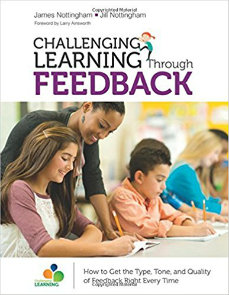Quality Feedback Begins with Good Assessment
Challenging Learning Through Feedback: How to Get the Type, Tone and Quality of Feedback Right Every Time
By James Nottingham and Jill Nottingham
(Corwin, 2017 – Learn more)

I stayed up all night last night. Why? Blame the Nottinghams – after reading their book, I wanted to write and rewrite the formative assessments I use in my day-to-day teaching. Challenging Learning Through Feedback is an inspiring read!
The Formative Assessment and Feedback Connection

Further, Nottingham and Nottingham remind us that the word assessment, at its root, means to “sit beside.” Assessment, when offered as a part of the teacher-student coaching relationship, provides insight for students to “better understand what they might be able to do to improve” (p. 11) and encourages student responsibility. Strong feedback should help students answer three questions:
- What am I trying to achieve?
- How much progress have I made so far?
- What should I do next?
The Chapters
There are eight chapters in the book and they can be loosely organized into three parts.
Part 1: What is feedback?
Chapters one and two are focused on detailing the information discussed above.
Types of feedback are shared, the difference between grades and formative assessment are described, and a list of characteristics of good feedback is offered.
Part 2: What are the prerequisites for quality feedback?
The next four chapters offer research, information and resources for creating a culture conducive to challenging learning through feedback, establishing quality learning goals (often referred to as clarified learning intentions), and taxonomies to support quality assessments to use as a basis for feedback.
A very powerful powerful message comes from these chapters. One, students must be aware of both learning intentions and the success criteria for examining their own progress in relation to the learning intention. The authors state that “Learning Intentions and Success Criteria should always be:
- understood by your students
- matched to each individual’s needs
- connected to big, worthwhile ideas
- meaningful to your student’s lives” (p. 60)
Further Nottingham and Nottingham drive home the notion that students need concrete examples to show them what success looks like for a given learning intention. They describe these examples with the phrase, “what a good one looks like” (p. 26) and dub the examples of meeting success criteria with the acronym, WAGOLL.
Part 3: How do I give quality feedback?
The last chapters, seven and eight, speak specifically to the title of the book. They give step-by-step guidelines and tools for giving feedback. In fact, the authors write, “please consider the previous six chapters as the warm-up to [these] chapters” (p. 181).
I will end this review the same way I started it, Challenging Learning Through Feedback is an inspiring book! I can honestly say that my own ability to use formative assessments to give quality feedback to my students has been greatly enhanced through reading it.
Rita Platt (@ritaplatt) is a National Board Certified teacher with master’s degrees in reading, library, and leadership. Her experience includes teaching learners in remote Alaskan villages, inner cities, and rural communities. She currently is a teacher-librarian, teaches graduate courses for the Professional Development Institute and writes for We Teach We Learn.


































